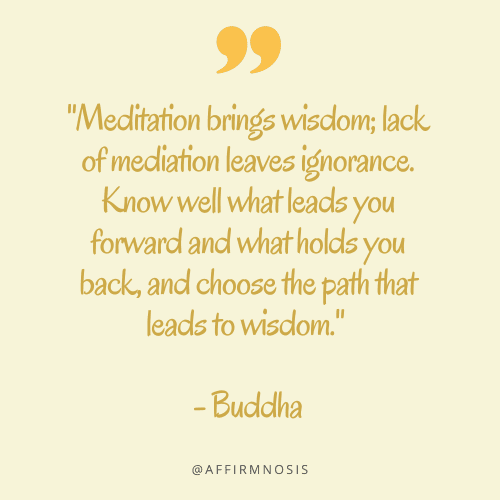Insight meditation, also known as Vipassana meditation, is a form of Buddhist meditation that involves developing self-awareness through the practice of mindfulness. The goal of insight meditation is to observe and understand the nature of one’s mind and its relationship with the external world.
The Art of Insight Meditation
This type of meditation encourages practitioners to examine their thoughts, emotions, and physical sensations in order to gain insight into their true nature. The term Vipassana derives from the Pali language, which means “seeing things as they really are.” This technique was first taught by Gautama Buddha over 2500 years ago.
It is a non-sectarian technique that has been practiced by people from all walks of life and religious backgrounds. The practice has been adapted over time to be more accessible to modern practitioners.
A Brief History and Origins
Insight meditation has its roots in ancient Indian philosophy. It was first taught by Gautama Buddha as part of his teachings on the Four Noble Truths. Over time, this technique spread throughout Southeast Asia and became an integral part of Theravada Buddhism.
In recent years, insight meditation has gained popularity in Western countries due to its ability to provide practitioners with tools for stress reduction, emotional regulation, and improved cognitive function. This interest has led to an increased awareness of this ancient tradition.
The Importance in Modern Times
In today’s fast-paced world, many people experience stress and anxiety on a daily basis. Insight meditation helps individuals develop tools for coping with these challenges while gaining a deeper understanding of themselves and their surroundings.
This practice can help individuals cultivate compassion for themselves and others while reducing negative emotions such as anger or resentment. By becoming more aware of one’s thoughts and emotions through mindfulness practices such as insight meditation, individuals can learn how to manage their reactions to difficult situations in a more constructive manner.
Additionally, insight meditation has been shown to have numerous health benefits, including reducing stress levels, lowering blood pressure, and improving immune system function. This makes it a valuable tool for both mental and physical well-being.
Overall, insight meditation is a powerful tool for personal growth and increased self-awareness. It offers practitioners a way to cultivate mindfulness in their daily lives while developing the ability to respond to life’s challenges with wisdom and compassion. By understanding the origins of this practice and its importance in modern times, individuals can gain a deeper appreciation for the valuable insights that can be gained through regular practice.

Understanding the Basics of Insight Meditation
The Four Foundations of Mindfulness
Insight meditation is based on the Four Foundations of Mindfulness, which are critical aspects that practitioners should focus on to achieve a higher state of consciousness.
The first foundation is mindfulness of the body, which involves paying attention to physical sensations, movements, and breathing patterns. Practitioners learn how to breathe deeply and observe their breath without judgment or attachment. This foundation helps individuals become more aware of their bodily sensations, which can help with stress reduction and overall well-being.
The second foundation is mindfulness of feelings or emotions. This foundation involves observing one’s emotional states without judgment or engaging in a story about them. Practitioners learn to identify different types of emotions such as joy, anger, sadness, or fear and how they manifest in the body. The third foundation is mindfulness of thoughts or mental states.
The Third Foundation is Contemplation of Mind. This foundation teaches practitioners how to observe thoughts as they arise without getting caught up in them. Rather than focusing on the content of each thought, practitioners simply note its presence and let it pass by.
The fourth foundation is mindfulness of mental objects such as ideas or perceptions. This final foundation teaches practitioners how to observe concepts as they arise and become aware that all ideas are self-created constructs with no inherent truth.
The Five Hindrances to Insight Meditation
There are five hindrances that practitioners should be aware of when practicing insight meditation because these mental states can hinder progress towards enlightenment.
The first hindrance is sensual desire – the craving for pleasure through sensory experiences such as food, sex, or material possessions. These desires create attachments that lead to suffering in life.
The second hindrance is ill-will or aversion where one holds negative feelings towards others either out jealousy or resentment resulting in further suffering for oneself and others.
The third hindrance relates to sloth & torpor, which is characterized by lethargy and drowsiness. This state can occur when practitioners become too relaxed or begin to feel bored or disinterested in meditating.
The fourth hindrance is restlessness and worry, which is characterized by an overactive mind that is constantly jumping from one thought to another. This mental state can be quite distressing and can make it difficult for practitioners to meditate. Doubt relates to a lack of faith in oneself or the practice of meditation.
The fifth hindrance is doubt. A doubting mind tends to question everything, including the purpose of meditation itself. It is important for practitioners to acknowledge these hindrances when they arise but not get attached or caught up in them as this would only lead to more suffering.
The Practice of Insight Meditation
Before starting with the practice of insight meditation, it is important to create an environment that is conducive to meditation. This means finding a space that is free from distractions, as well as clutter-free and comfortable.
Preparation for Practice
You may want to dim the lights, light a candle or some incense, and play some soft background music to help set the tone. Secondly, choosing a comfortable posture is essential for successful meditation practice.
You can sit cross-legged on a cushion or mat on the floor or use a chair if sitting on the floor is uncomfortable for you. Ensure your spine is straightened and your chin slightly tucked in to keep your head level.
Setting an intention for practice helps you stay focused during your meditation session by giving you direction and purpose. You may choose an intention that resonates with you and repeat it silently in your mind before starting each session.
Guided Meditation Instructions
Insight meditation involves various techniques that can help focus attention and cultivate awareness. One such technique is breath awareness meditation where one focuses on their breathing pattern while maintaining awareness of bodily sensations and thoughts arising in their minds. Body scan meditation involves bringing attention to various parts of your body while slowly scanning through them from head to toe or vice versa while observing any sensations or thoughts arising.
Loving-kindness mediation involves cultivating feelings of compassion towards oneself, loved ones, acquaintances, adversaries as well as all sentient beings across all time frames. Walking meditation involves walking slowly whilst being aware of sensations arising in one’s feet as they touch the ground whilst also being aware of what’s happening around them
Open awareness mediation involves observing thoughts without judging them as good/bad/positive/negative but simply accepting what arises without attachment It’s important to note that there are no hard-and-fast rules when it comes to guided meditation, and you can choose the techniques that best suit your needs and preferences.
Breath Awareness Meditation
Breath awareness meditation is one of the most commonly used techniques in insight meditation practice. It involves focusing on your breath as it enters and leaves your body.
During this type of meditation, it’s important to observe how thoughts come and go without getting carried away by them. Simply redirect your attention back to the breath whenever you become aware of being distracted.
Body Scan Meditation
Body scan meditation is a technique that helps bring awareness to different parts of the body while cultivating mindfulness. During this type of meditation, focus on each part of your body, starting from the top of your head down to your toes. Pay attention to any physical sensations or emotions arising from each part as you scan through it.
Loving-Kindness Meditation
Loving-kindness mediation helps cultivate feelings of compassion towards oneself, loved ones, acquaintances, adversaries as well as all sentient beings across all time frames. This type of mediation involves visualizing a person or group in front of you and silently reciting phrases such as “may they be happy,” “may they be healthy,” “may they be safe,” “may they live with ease.” As you repeat these phrases in your mind gradually expand them outwards until you encompass all beings across all locations and time periods
Walking Meditation
Walking meditation is a great way to bring movement into your mindfulness practice. It involves walking slowly whilst being aware of sensations arising in one’s feet as they touch the ground whilst also being aware of what’s happening around them
Open Awareness Meditation
Open awareness mediation involves observing thoughts without judging them as good/bad/positive/negative but simply accepting what arises without attachment This technique helps cultivate equanimity and acceptance towards all thoughts and sensations that arise in the mind. It involves observing your thoughts as they come and go, without getting caught up in them or trying to change them.
The Benefits of Insight Meditation
Insight meditation is not just a practice that leads to spiritual awakening, but also a practice that can benefit our physical health. The benefits of this form of meditation on the body are numerous and well documented.
Physical Benefits: A Healthier Body Through Mindful Awareness
One of the most significant physical benefits of insight meditation is a reduction in stress levels. Studies have shown that regular practice can lead to decreased levels of cortisol, the hormone associated with stress.
With lower levels of cortisol, we experience less anxiety and tension, leading to improved overall health. In addition to reducing stress levels, insight meditation has been linked to lowering blood pressure.
High blood pressure is often referred to as the “silent killer” because it can lead to serious conditions like heart disease and stroke. By practicing mindfulness and bringing awareness to our thoughts and feelings, we become better equipped to manage stressors that contribute to high blood pressure.
Furthermore, insight meditation has also been found to improve immune system function. The mind-body connection is powerful and research has shown that regular practice can strengthen our immune system response by increasing the production of antibodies in response to viruses or other illnesses.
Psychological Benefits: A Healthier Mind Through Mindful Awareness
The psychological benefits of insight meditation are just as impressive as its physical benefits. Regular practice has been found to be effective in reducing symptoms associated with anxiety and depression. Those who suffer from these mental health disorders often find relief through mindfulness practices that help them focus on the present moment rather than dwelling on negative thoughts or feelings.
In addition, insight meditation helps improve emotional regulation by teaching us how to observe our thoughts without judgment or reaction. This skill allows us greater control over how we respond emotionally when faced with difficult situations or triggers.
One lesser-known benefit is its enhancement on cognitive function such as memory retention and attention span. The practice of staying present and focused prepares our minds to be more alert and less distracted which translates into better cognitive performance.
Insight meditation is a powerful tool that can help us lead healthier, happier lives. Its benefits are numerous and holistic, reaching both the mind and body.
By practicing mindfulness, we can reduce stress levels, lower blood pressure, improve immune system function, reduce anxiety and depression symptoms while improving emotional regulation capabilities and enhancing cognitive function. This practice may not only lead to spiritual enlightenment but also to a better quality of life here on Earth.
Common Misconceptions about Insight Meditation
It is only for Buddhists
Insight meditation, also known as Vipassana meditation, is a technique that originated in Buddhist teachings. However, it is important to note that this practice has evolved and has been adopted by people of various religious beliefs or those with no religious affiliation at all. The practice of insight meditation requires no specific religious belief nor does it require one to follow any dogma or doctrine.
It is a practice that can be integrated into anyone’s life irrespective of their cultural background, religion, gender or race. Furthermore, insight meditation can be beneficial to people regardless of their beliefs.
It helps an individual to cultivate mindfulness and awareness which in return promotes mental well-being. It is not about converting one’s beliefs but rather a technique for self-awareness and personal growth.
It requires sitting in silence for hours on end
One common misconception about Insight Meditation is that it requires sitting cross-legged for hours on end without moving or talking. However, this idea is far from the truth as the practice can be done anywhere and at any time. While it may be beneficial to have a dedicated space for meditation practice, it is not necessary.
Moreover, there are various types of Insight Meditation practices such as walking meditation or body scan meditation which do not require sitting still for extended periods of time. Also, the duration of the practice varies from person to person based on their preference and availability of time.
It is a form of escapism
Some people think that insight meditation is a form of escapism practiced by individuals who want to escape from reality or responsibilities in life. However, this belief could not be further from the truth.
Insight Meditation encourages individuals to face reality head-on without judgment while cultivating self-awareness and acceptance. The goal isn’t to escape from reality but rather to understand it better.
Through insight meditation, individuals learn to observe their thoughts and emotions without judgment and use this awareness to respond appropriately in any situation. Insight meditation is a tool for growth and progress, not an escape route from reality.
Insight Meditation is a practice that has been shrouded in misconceptions over the years. It is not only for Buddhists, does not require sitting in silence for hours on end and most certainly isn’t a form of escapism.
Understanding these common misconceptions can help individuals embrace the practice with an open mind and impartial attitude. Insight Meditation holds immense benefits for an individual’s well-being regardless of their beliefs or religion.
It promotes self-awareness, cultivates mindfulness which helps reduce stress levels, enhances cognitive function, improves emotional regulation among other benefits listed previously. With proper guidance and consistent practice, anyone can incorporate Insight Meditation into their lives to promote mental health and overall well-being.
Insight Meditation is a Path to Inner Peace and Self-Discovery
Insight meditation is truly a transformative practice that can help you rediscover the true nature of your mind and gain greater clarity about your emotions, thoughts, and behaviors. Practicing mindfulness on a regular basis can help you cultivate inner peace, compassion, and wisdom. By cultivating present-moment awareness and non-judgmental acceptance of your experiences, you can learn to respond to life’s challenges with more equanimity.
The Journey of Insight Meditation is Ongoing
Insight meditation is not a quick fix or cure-all for the complexities of life. It requires effort, dedication, and patience.
The journey towards self-awareness and healing is ongoing, but the rewards are immeasurable. Making time for daily practice can lead to profound changes in how you experience yourself and the world around you.
The Practice of Insight Meditation Can be Adapted to Suit Your Needs
One common misconception about insight meditation is that it only involves sitting in silence for hours on end. While silent sitting meditation is an essential part of the practice, there are many other ways to cultivate mindfulness throughout your day-to-day life. Whether it’s through mindful movement such as yoga or tai chi or practicing gratitude during daily activities like eating or walking outside; there are countless ways to incorporate mindfulness into your routine.
The Benefits of Insight Meditation Extend Beyond Yourself
By cultivating greater awareness of our inner experiences through insight meditation, we naturally become more attuned to our impact on others and the world around us. As we develop greater compassion for ourselves, we also extend this compassion towards others – leading to less conflict in our relationships with friends, family members and colleagues at work.
; Insight meditation can be a powerful tool for personal growth that helps us gain clarity and equanimity amidst the challenges of life. Whether you are looking to reduce stress, improve relationships, or cultivate greater self-awareness; insight meditation has numerous benefits that can enrich your life in countless ways.
So, why not take some time today to begin your journey towards greater mindfulness? With practice and persistence, you too can experience the transformative power of insight meditation.
Quotes on Insight Meditation (Vipassana)
- “The mind is everything. What you think you become.” – Buddha
- “Meditation is not a means to an end. It is both the means and the end.” – Jiddu Krishnamurti
- “Meditation is a way for nourishing and blossoming the divinity within you.” – Amit Ray
- “Meditation is the soul’s perspective glass.” – Owen Feltham
- “Meditation brings wisdom; lack of mediation leaves ignorance. Know well what leads you forward and what holds you back, and choose the path that leads to wisdom.” – Buddha
- “In the midst of movement and chaos, keep stillness inside of you.” – Deepak Chopra
- “Meditation is the tongue of the soul and the language of our spirit.” – Jeremy Taylor
- “Meditation is not to escape from society, but to come back to ourselves and see what is going on. Once there is seeing, there must be acting. With mindfulness, we know what to do and what not to do to help.” – Thich Nhat Hanh
- “Meditation is the ultimate mobile device; you can use it anywhere, anytime, unobtrusively.” – Sharon Salzberg
- “The thing about meditation is: You become more and more you.” – David Lynch
- “Meditation is the dissolution of thoughts in eternal awareness or pure consciousness without objectification, knowing without thinking, merging finitude in infinity.” – Voltaire
- “The best way to capture moments is to pay attention. This is how we cultivate mindfulness.” – Jon Kabat-Zinn
- “Mindfulness isn’t difficult, we just need to remember to do it.” – Sharon Salzberg
- “The most precious gift we can offer others is our presence. When mindfulness embraces those we love, they will bloom like flowers.” – Thich Nhat Hanh
- “Mindfulness is about being fully awake in our lives. It is about perceiving the exquisite vividness of each moment.” – Jon Kabat-Zinn
- “Mindfulness is the aware, balanced acceptance of the present experience.” – Sylvia Boorstein
- “In today’s rush, we all think too much — seek too much — want too much — and forget about the joy of just being.” – Eckhart Tolle
- “Feelings come and go like clouds in a windy sky. Conscious breathing is my anchor.” – Thich Nhat Hanh
- “The most fundamental aggression to ourselves, the most fundamental harm we can do to ourselves, is to remain ignorant by not having the courage and the respect to look at ourselves honestly and gently.” – Pema Chödrön
These quotes emphasize the transformative power of meditation, its role in self-discovery, and its potential to bring about a sense of peace and wisdom.
20 affirmations useful in supporting your Insight Meditation (Vipassana) practice:
- I am present in this moment.
- My mind is calm, clear, and focused.
- I trust the process of meditation.
- I am patient with my progress.
- Each breath brings me closer to inner peace.
- I am becoming more aware and mindful each moment.
- My mind is open to new insights and understandings.
- I am compassionate towards myself and my experiences.
- I allow thoughts and emotions to come and go without judgment.
- My mind and body are interconnected and unified.
- I am creating a space of stillness within me.
- I am not my thoughts, I am the observer of my thoughts.
- I am deeply connected to the present moment.
- With each meditation, my awareness deepens.
- I gently return my attention to the present moment, no matter how many times it wanders.
- I am cultivating an inner refuge of peace and calm.
- I am connected to all beings through the energy of mindfulness.
- I embrace the impermanence of all things.
- Each moment offers a new opportunity for mindfulness.
- I honor the wisdom that arises from deep listening and observation.
Remember, affirmations can be a wonderful tool to set intention and focus, but they are not a substitute for the actual practice of Insight Meditation. They should ideally be used in conjunction with regular meditation practice.




























































